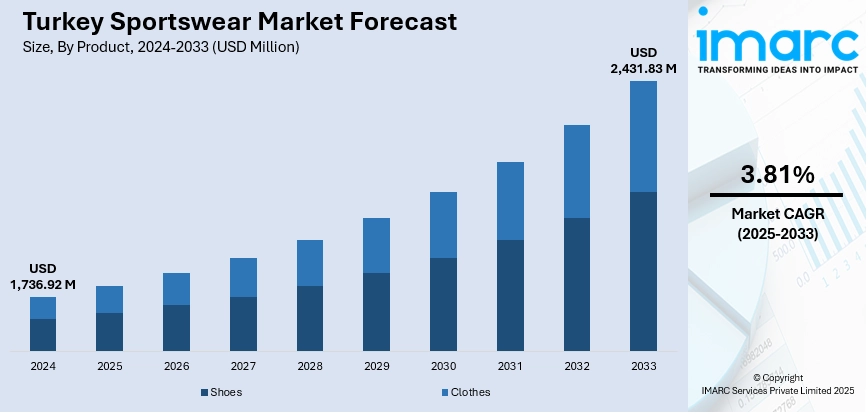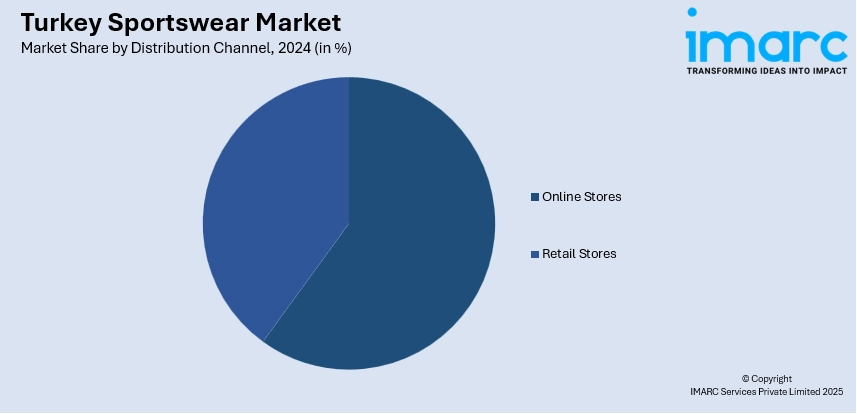
Turkey Sportswear Market Size, Share, Trends and Forecast by Product, Distribution Channel, End User, and Region, 2025-2033
Turkey Sportswear Market Overview:
The Turkey sportswear market size reached USD 1,736.92 Million in 2024. Looking forward, the market is expected to reach USD 2,431.83 Million by 2033, exhibiting a growth rate (CAGR) of 3.81% during 2025-2033. The market is experiencing steady growth, driven by rising health awareness, increased participation in fitness activities, and a shift toward athleisure fashion. E-commerce platforms and influencer marketing are further boosting demand, especially among younger consumers seeking comfort and style in daily wear. These factors collectively contribute to the expanding Turkey sportswear market share.
|
Report Attribute
|
Key Statistics
|
|---|---|
|
Base Year
|
2024
|
|
Forecast Years
|
2025-2033
|
|
Historical Years
|
2019-2024
|
| Market Size in 2024 | USD 1,736.92 Million |
| Market Forecast in 2033 | USD 2,431.83 Million |
| Market Growth Rate 2025-2033 | 3.81% |
Turkey Sportswear Market Trends:
Growth of the Athleisure Trend
Athleisure, a blend of athletic and casual wear, has become a dominant force in Turkey’s fashion scene, significantly boosting sportswear sales. Customers are more attracted to the multifunctional clothes which are comfortable and fashionable in everyday life. With the relaxed nature of dress codes in the workplace and the increased spreading of remote work, the distinction between active and everyday styles is becoming even more relaxed. This trend has been particularly common with the millennials and Gen Z, who invest in aesthetics and utility of a garment. The Turkish brands and retailers are reacting to these changes with trend-forward designs, quality materials as well as gender-neutral lines. Foreign brands are also increasing their local presence to respond to this increasing client base. Athleisure’s broad appeal across age groups and lifestyles makes it a major growth engine for the Turkey sportswear market.

To get more information on this market, Request Sample
Expansion of E-Commerce and Omni-Channel Retail
The fast-developing of e-commerce and omni-channel retailing are stimulating the growth of the Turkey sportswear market. Consumer can easily compare a product, get discounts, and shop through video and audio format of online platforms at the comfort of their residences of widely ranging local and international brands. Larger competitors, including the Turkish e-commerce actors, are also spending intensively on making the sites and mobile applications user-friendly and being able to provide consumers with prompt delivery services. Advanced navigational features like virtual fitting rooms, recommendation engines that use AI to make product suggestions and campaigns led by influencers allow customers to find more and prompt them to act. In addition, the integration of offline and online strategies, such as click-and-collect or in-store returns for online purchases, further boosts consumer convenience. This seamless shopping ecosystem supports the rising demand for sportswear across urban and semi-urban regions of Turkey.
Youth Demographics and Lifestyle Shifts
Turkey’s youthful population and evolving consumer behavior are critical drivers of the Turkey sportswear market growth. A large segment of the population is under 35 years old, tech-savvy, fashion-conscious, and highly influenced by global trends. These younger consumers are increasingly embracing sportswear not just for physical activity but also as a key element of their everyday wardrobes. Social media platforms like Instagram and TikTok play a central role in shaping preferences and amplifying brand messaging. Influencer marketing and celebrity collaborations are particularly effective in capturing this demographic. Additionally, rising disposable incomes and a focus on individuality and self-expression have encouraged frequent apparel purchases. As young consumers continue to prioritize comfort, identity, and digital engagement, sportswear brands in Turkey are adapting with fresh designs and targeted campaigns.
Turkey Sportswear Market Segmentation:
IMARC Group provides an analysis of the key trends in each segment of the market, along with forecasts at the country and regional levels for 2025-2033. Our report has categorized the market based on product, distribution channel, and end user.
Product Insights:
- Shoes
- Clothes
The report has provided a detailed breakup and analysis of the market based on the product. This includes shoes and clothes.
Distribution Channel Insights:

- Online Stores
- Retail Stores
A detailed breakup and analysis of the market based on the distribution channel have also been provided in the report. This includes online stores and retail stores.
End User Insights:
- Men
- Women
- Kids
A detailed breakup and analysis of the market based on the end user have also been provided in the report. This includes men, women, and kids.
Regional Insights:
- Marmara
- Central Anatolia
- Mediterranean
- Aegean
- Southeastern Anatolia
- Black Sea
- Eastern Anatolia
The report has also provided a comprehensive analysis of all the major regional markets, which include Marmara, Central Anatolia, Mediterranean, Aegean, Southeastern Anatolia, Black Sea, and Eastern Anatolia.
Competitive Landscape:
The market research report has also provided a comprehensive analysis of the competitive landscape. Competitive analysis such as market structure, key player positioning, top winning strategies, competitive dashboard, and company evaluation quadrant has been covered in the report. Also, detailed profiles of all major companies have been provided.
Turkey Sportswear Market News:
- In May 2023, MarkaLab’s decision aligned with its broader strategy to enhance international supply chain operations and advance its global market expansion initiatives. Centric Software delivers robust Product Lifecycle Management (PLM) solutions that support the end-to-end process of planning, designing, developing, sourcing, and marketing products across multiple sectors such as apparel, footwear, and home furnishings.
Turkey Sportswear Market Report Coverage:
| Report Features | Details |
|---|---|
| Base Year of the Analysis | 2024 |
| Historical Period | 2019-2024 |
| Forecast Period | 2025-2033 |
| Units | Million USD |
| Scope of the Report |
Exploration of Historical Trends and Market Outlook, Industry Catalysts and Challenges, Segment-Wise Historical and Future Market Assessment:
|
| Products Covered | Shoes, Clothes |
| Distribution Channels Covered | Online Stores, Retail Stores |
| End Users Covered | Men, Women, Kids |
| Regions Covered | Marmara, Central Anatolia, Mediterranean, Aegean, Southeastern Anatolia, Black Sea, Eastern Anatolia |
| Customization Scope | 10% Free Customization |
| Post-Sale Analyst Support | 10-12 Weeks |
| Delivery Format | PDF and Excel through Email (We can also provide the editable version of the report in PPT/Word format on special request) |
Key Questions Answered in This Report:
- How has the Turkey sportswear market performed so far and how will it perform in the coming years?
- What is the breakup of the Turkey sportswear market on the basis of product?
- What is the breakup of the Turkey sportswear market on the basis of distribution channel?
- What is the breakup of the Turkey sportswear market on the basis of end user?
- What is the breakup of the Turkey sportswear market on the basis of region?
- What are the various stages in the value chain of the Turkey sportswear market?
- What are the key driving factors and challenges in the Turkey sportswear market?
- What is the structure of the Turkey sportswear market and who are the key players?
- What is the degree of competition in the Turkey sportswear market?
Key Benefits for Stakeholders:
- IMARC’s industry report offers a comprehensive quantitative analysis of various market segments, historical and current market trends, market forecasts, and dynamics of the Turkey sportswear market from 2019-2033.
- The research report provides the latest information on the market drivers, challenges, and opportunities in the Turkey sportswear market.
- Porter's five forces analysis assist stakeholders in assessing the impact of new entrants, competitive rivalry, supplier power, buyer power, and the threat of substitution. It helps stakeholders to analyze the level of competition within the Turkey sportswear industry and its attractiveness.
- Competitive landscape allows stakeholders to understand their competitive environment and provides an insight into the current positions of key players in the market.
Need more help?
- Speak to our experienced analysts for insights on the current market scenarios.
- Include additional segments and countries to customize the report as per your requirement.
- Gain an unparalleled competitive advantage in your domain by understanding how to utilize the report and positively impacting your operations and revenue.
- For further assistance, please connect with our analysts.
 Request Customization
Request Customization
 Speak to an Analyst
Speak to an Analyst
 Request Brochure
Request Brochure
 Inquire Before Buying
Inquire Before Buying




.webp)




.webp)












